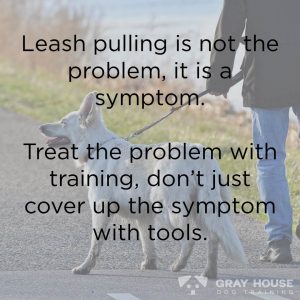The Introduction
There are dozens of leash walking tools on the market today. Many companies try to market their product as the perfect solution to leash pulling. “Just use our equipment and your dog will never pull again.”
Unfortunately, these companies only sell the tools, not the methods or techniques to actually train the dogs that wear them.
 No tool on its own can stop a dog from pulling on a leash. Why? Because it takes training to stop that behavior, not a tool. Tools do not train dogs, people train dogs, sometimes with the help of tools.
No tool on its own can stop a dog from pulling on a leash. Why? Because it takes training to stop that behavior, not a tool. Tools do not train dogs, people train dogs, sometimes with the help of tools.
The problem with these tools is they address the symptom, not the root cause. You may reduce pulling with certain leash walking tools, but you aren’t addressing why the dog is pulling in the first place.
Is he terrified of being outside? Overstimulated by so many things to smell and chase? Or is he just used to wandering where he pleases on the walk instead of being with you?
The answer may determine what specific tool you need and how to use it. In this article, we’re going to review the most common leash walking tools, why they are effective or ineffective, and when it is appropriate to choose one tool over another. These tools will specifically be things you put onto your dog to help with leash pulling on the walk. There will be a separate article on leashes and their uses.
Flat Collars
Flat collars are quickly becoming less popular as a leash walking tool, and for good reason. A dog that pulls can, over time, cause damage to their trachea. It is now more common to see flat collars used for a dog’s identification or just for decoration.
It’s important to note that it is not impossible or wrong to walk a dog using only a flat collar. If your dog naturally doesn’t pull on the lead, there’s no risk of injury using a flat collar. However, if your dog does pull, I recommend incorporating a balance of training and a new walking tool. You can transition back to the flat collar after your dog is trained to walk on a loose leash.
A Note on Martingale Collars
I consider martingale collars to be a subcategory of flat collars. It was designed for dog breeds with a very pronounced trachea like greyhounds and Dobermans. The collar tightens around the entire neck as a way to distribute even pressure. This, in theory, prevents damage to the trachea.
The design of the martingale is more gentle at distributing leash pressure to a dog. I find, though, that they are still not very safe. The pressure made with the martingale collar is not focal enough for the dog to recognize it as communication from the owner. You can learn more about this concept of pressure conditioning in a later article.
Harnesses
Harnesses have become very popular in the leash walking scene. Dozens of brands tote ‘no-pull’ harnesses with straps and clips everywhere. It’s very common to see dogs walking on the street or running around the dog park with their harness on.
I personally see this as one of many developing problems in the dog world. Harnesses make pulling easier for a dog, distributing the weight on the leash evenly across a dog’s frame. This allows the dog to use its whole body to pull. In other words, these harnesses naturally encourage pulling, completely falsifying the claims of the harness brand’s advertising.
Some harnesses hook at the front of the body, so that when the dog pulls, the pivot point of the harness sets the dog off balance and presses against the dog’s shoulders, making pulling uncomfortable. Although the concept is solid, it still does not teach a dog not to pull while on lead. Many harnessed dogs still pull, they just can’t put their full weight behind the pulling, so the owner no longer sees it as a problem. Over time, the dog becomes desensitized to the pressure on its shoulders and continues to pull. When used for long periods, harnesses like this can cause unnatural wear and potential damage to the dog’s shoulders.
There are some rare cases where a harness is the best tool for a dog. One of my own clients, Dakota, could not wear anything on his neck and so a harness was the best option for him. But as with using any tool, you must give your dog input and train it to not pull. You cannot rely on the tool to do all the work.
Slip Collars (or Leads) and Choke Chains
Slip collars and choke chains do not ‘choke’ or otherwise harm the dog wearing it as the name may suggest. These tools act like a lasso – a continuous piece of chain or rope goes through a loop at one end, creating an adjustable opening. The even pressure created by the adjustable opening establishes communication with the dog, defined through proper training and conditioning.

Like many training tools, slip leads and choke chains have been given a bad reputation in some schools of dog training. There are two contributing factors to this bad rep: the growing popularity of force-free training, which is against any use of physical influence over a dog’s behavior, and uneducated owners and trainers using these tools improperly to the detriment of their dogs. Like any tool, when used properly and in the context of a proper training plan, the slip lead is highly effective and safe to use. It is my personal go-to for training any of my clients’ dogs to walk at a heel on leash.
Head Halters
Otherwise known as a Gentle Leader, a head halter is just as it sounds – a dog-sized halter collar that goes over the base of the snout and around the neck, typically hooked to the leash from underneath the jaw.
It is a very foreign feeling for a dog to have something over the bridge of its nose; this is both a benefit and fallback of the head halter. For some dogs, this feeling just helps emphasize the focal pressure made if the dog pulls, which helps the owner train the dog not to pull. On the other hand, some dogs are so distracted that they can’t absorb the training at hand. It is something you must test with your own dog to determine if it is the right tool to help you.
An alternative to buying a head halter is to use your slip lead to make a temporary one. I put together a very simple tutorial on using the slip lead to make a head halter here.
Prong Collars
 The prong collar is one of the most misunderstood and persecuted tools in the dog training world, second only to remote shock collars. The prong collar may appear intimidating, but make no mistake, improper use of the tool and the stigma that has been inflated around that use are the cause of its bad reputation.
The prong collar is one of the most misunderstood and persecuted tools in the dog training world, second only to remote shock collars. The prong collar may appear intimidating, but make no mistake, improper use of the tool and the stigma that has been inflated around that use are the cause of its bad reputation.
For some dogs, the outside world is too distracting or too overwhelming. That is what the head halter and prong collar are for. They provide a more focal pressure that the mind and body can recognize and respond to in higher states of arousal.
I still highly recommend that you consult with a professional before using these tools. A professional will ensure you have a proper understanding of the use of these tools.
A Note on Alternative Prong Collars
There are a few alternatives to the prong collar on the market today. The most popular is the Starmark Academy Pro-Training Collar. This plastic alternative has gained popularity with some trainers because of its less intimidating look. I have also known trainers to use this tool specifically on older puppies as a transition into the regular prong.
Although I appreciate the purpose of the Starmark, I have never found a need to use it in particular. I have seen it used effectively with many dogs and if I were to come upon a dog or owner in need of a prong-level walking tool but who could not or would not use the prong itself, I would certainly utilize it as an option.
E-Collars
There are many trainers who advocate the use of a remote shock collar or e-collar to train a reliable loose leash or off leash heel walk. The e-collar can certainly be a solid and versatile tool for communicating with your dog; however, I do not recommend going out and buying one just to create a good heel. If you are going to use the e-collar, your goal should be to use it in every aspect of your dog’s training to make it worth your investment.
I prefer to train using less expensive tools and methods, and only recommend and use e-collars for those dog owners who have specific needs for long-distance communication or who need remote communication due to their or their dog’s medical needs.
Gray House Leash Walking Tools
There is really no leash walking tool that is out of bounds for Gray House Dog Training. If the tool fits the needs of the dog and owner, that is what I’m going to use.
That being said, there are tools that I strongly prefer to use with typical leash pulling cases: the slip lead, the head halter, and the prong collar.
 Consider this analogy (it is one of my favorites). My husband is taking a nap on the couch and I need to wake him up. I first walk up to him and nudge his shoulder gently, whispering in his ear to wake up. It turns out he is in a deep sleep, so a nudge is not enough to wake him. Since I need to wake him up, I raise my voice and poke him in the cheek, which does the trick.
Consider this analogy (it is one of my favorites). My husband is taking a nap on the couch and I need to wake him up. I first walk up to him and nudge his shoulder gently, whispering in his ear to wake up. It turns out he is in a deep sleep, so a nudge is not enough to wake him. Since I need to wake him up, I raise my voice and poke him in the cheek, which does the trick.
Your dog is the sleeping husband, and each tool is a way to ask them to focus. The nudge to the shoulder is equivalent to the slip lead. It provides subtle, even pressure that, when conditioned properly, tell the dog to focus. The head halter and prong collar are variations of the poke, providing more focal pressure that is easier to recognize and respond to in high distraction scenarios.
To learn more about how to pressure condition your dog for loose leash walking, look out for our next article. And if you would like a live demonstration and one-on-one help with choosing the right leash walking tool for your dog and learning how to use it properly, book a consultation with me.




